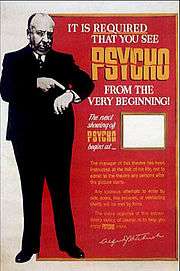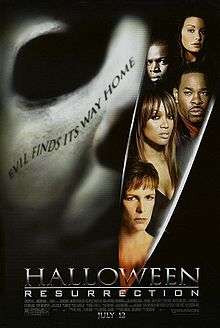False protagonist

In fiction, a false protagonist is a literary technique, often used to make the plot more jarring or more memorable by fooling the audience's preconceptions, that constructs a character who the audience assumes is the protagonist but is later revealed not to be.
A false protagonist is presented at the start of the fictional work as the main character, but then is eradicated, often by killing them (usually for shock value or as a plot twist) or changed in terms of their role in the story (i.e. making them a lesser character, a character who leaves the story, or revealing them to actually be the antagonist).[2]
Overview
In film, a character can be made to seem like the main protagonist based on a number of techniques (beyond just simply focusing the plot on their role). Star power is a very effective method; audience members generally assume that the biggest "name" in a movie will have a significant part to play. An abundance of close-ups can also be used as a subliminal method. Generally, the star of a film will get longer-lasting and more frequent close-ups than any other character, but this is rarely immediately apparent to viewers during the film. Alternatively, the false protagonist can serve as a narrator to the movie, encouraging the audience to assume that the character survives to tell their tale later.[3]
Many of the same techniques used in film can also apply to television, but the episodic nature adds an additional possibility. By ending one or more episodes with the false protagonist still in place, the show can reinforce the viewers' belief in the character's protagonist status. Also, because TV shows often have changes of cast between seasons, some series can have unintentional false protagonists: characters who begin the series as the main character but then are replaced early in the show's run by another character entirely. When the series is viewed as a whole, this can lead to the appearance of a false protagonist.
In video games, a false protagonist may initially be a playable character, only to be killed or revealed to be the antagonist. One key way in which video games employ the method that differs from uses in non-interactive fiction is by granting the player direct control over the false protagonist. Since most video games allow a player to control only the main characters (and their success or failure is based on playing skill, not pre-determined story), the sudden demise of the character that is being controlled serves to surprise the player.
Examples
Literature

- The Book of Samuel begins with Samuel's birth and God's call to him as a boy. At this point, the readers are led to believe that Samuel is the central figure in the book. Though by the sixteenth chapter, the book starts to primarily focus on David.[4]
- In Aldous Huxley's Brave New World readers are initially led to believe the protagonist is Bernard Marx until the introduction of John the Savage, at which point the story starts to almost entirely focus on John.
- In The Adventures of Captain Hatteras Richard Shandon, the first mate, appears as the main protagonist until Capatin Hatteras shows up. He is later revealed to be the main antagonist who incites the crew to mutiny.
- The Zero Game by Brad Meltzer also uses this technique. The book begins with Matthew Mercer, who then dies just six chapters in.
- George R. R. Martin's novel, A Game of Thrones, the first entry in the A Song of Ice and Fire epic fantasy series, features chapters told from the point of view of numerous characters, though the most prominent is Ned Stark, who is generally assumed to be the novel's main protagonist until the final chapters where he is unexpectedly executed.[5][6]
Film
- Alfred Hitchcock's film Psycho may be the first film to feature a false protagonist. It opens with Marion Crane as the main character. However, she is killed partway through the film, making the murder far more unexpected and shocking. Hitchcock felt that the opening scenes with Marion as the false protagonist were so important to the film that when it was released in theaters, he compelled theater owners to enforce a "no late admission" policy.[7]
- Perhaps the most famous false protagonists are C-3PO and R2-D2 from Star Wars. The film's opening sequence focuses on the two as they struggle to escape from the Tantive IV as it is overrun by Imperial stormtroopers. After they flee the ship on an escape pod to Tatooine, the film shifts its main focus to Luke Skywalker, the actual protagonist of the film.
- Stuart Baird's film Executive Decision has Austin Travis (Steven Seagal) to be one of the main protagonists, alongside Kurt Russell's character. Travis would then sacrifice himself in the first quarter of the film.
- In Stanley Kubrick's Full Metal Jacket, early scenes place focus on Private Gomer Pyle (Vincent D'Onofrio), however he is killed off midway through the movie.
- Tim Burton's Mars Attacks! had a series of notable actors who played false protagonists. They all either end up dying or being captured by the aliens. The actors who played false protagonists include Jack Nicholson, Pierce Brosnan and Michael J. Fox. The characters who survived were played by actors who were unknown at that time (Natalie Portman, for one).
- In Arachnophobia, nature photographer Jerry Manley (Mark L. Taylor) is initially portrayed as the protagonist. However, a few minutes into the film, he is bitten and killed by the venom of a poisonous spider, and the focus shifts to Dr. Ross Jennings (Jeff Daniels).
- Wes Craven's film Scream opens with Drew Barrymore's Casey Becker. She receives a threatening phone call from a mysterious person, only to be killed fifteen minutes into the film. Barrymore was usually featured in the film's promotional posters as she was the more notable actress from the film at that time.[8]
- Renny Harlin's Deep Blue Sea makes it fairly obvious that Russel Franklin (Samuel Jackson) is the main protagonist, only for the character to be brutally killed nearly halfway throughout the film.

- Halloween: Resurrection opens with Jamie Lee Curtis's character Laurie Strode, who was the main protagonist in the previous Halloween films, only to be murdered by the antagonist (Michael Myers) ten minutes into the film.
- In Mindhunters, J.D. (Christian Slater) was one of the central characters in the film's opening, alongside Sara (Kathryn Morris). However, J.D (Slater) was killed half hour into the film, and was the first character to be killed off. Val Kilmer's character Jack Harris was also ubiquitous at the beginning of the film, who was a leader. His character abruptly goes offscreen, until the other characters learn that he was killed.
- In Smokin' Aces, Ben Affleck's character is introduced and has a voice over narration that introduces many of the other characters before he is unexpectedly shot and killed early in the film.
- The Darjeeling Limited opens with a long sequence of Bill Murray in a hurry to catch a train. He misses it, and the rest of the film is about the three characters on the train who see him.
- The characters who appear in the first half of Quentin Tarantino's Death Proof seem to be the main protagonists, only for them to be killed off halfway throughout the film and be replaced by a new set of characters.
- In the Coen brothers film No Country for Old Men, Llewllyn Moss (Josh Brolin) appears to be the story's central character until he is killed offscreen midway in the movie and the narrative switches focus to the sheriff, played by Tommy Lee Jones.
- The remake of A Nightmare on Elm Street presents Katie Cassidy's character as the main protagonist before she gets killed partway through the film.
- Bryan Cranston's character Joe Brody appears to be the protagonist in Gareth Edwards' Godzilla, only to be killed off early in the film.
- Tom Hardy plays the title character Max in George Miller's Mad Max: Fury Road and is billed first on the posters and trailers. The film introduces the audience to Max and gives the appearance of him being the protagonist. However, partway into the film, the story focuses primarily on Imperator Furiosa, while Max is relegated to the role of a bystander in her storyline.
Television
- The first eight episodes of HBO's critically acclaimed drama "Game of Thrones" revolve around Ned Stark (Sean Bean), but he is executed at the end of the ninth episode ("Baelor").
- The first seven episodes of British drama Hex revolve around Cassie Hughes. At the end of the seventh episode, she is accidentally killed by Ella Dee, who in turn becomes the new protagonist.
- In the anime series Gurren Lagann, viewers are misled for the first few episodes into believing that Kamina is the protagonist of the series, but after a major plot twist, Simon takes over as the protagonist for the majority of the series.
- In the anime series Ga-rei many viewers had initially believed the story would revolve around central characters Touru and Natsuki, protagonists of the first episode. It was even believed after their deaths that they had not truly been replaced. Though the subsequent episodes, viewers will find Tsuchimiya Kagura and Isayama Yomi to be more central characters.
- In the pilot episode of the HBO prison drama series Oz it was seemingly established that the Italian inmate Dino Ortolani would be one of the series' main characters. The character was, however, killed at the end of the episode, with his death having a strong impact on the events of the series' first season.
Video game
- In Call of Duty 4: Modern Warfare, The player assumes the role of U.S Marine Sgt. Paul Jackson. Towards the end of the first act Sgt. Jackson is killed in a nuclear explosion.
- In Fatal Frame, the player assumes the role of Mafuyu in the prologue. Then after that, Miku, Mafuyu's sibling, becomes the main protagonist.
- In Metal Gear Solid 2: Sons of Liberty, the player initially plays as Solid Snake, protagonist of the original Metal Gear games. However, the majority of the game after that is played with Raiden, with Snake taking on only a minor role in the story.
- In Final Fantasy XII, the player start the game playing as a young soldier named Reks. After less than an hour of gameplay, Reks is suddenly killed, and the game resumes play following Vaan, Reks' younger brother.
- In Kingdom Hearts II, Roxas is initially portrayed as the protagonist in the first few hours of gameplay. However, after finding the pod in which Sora has been imprisoned for more than a year, he vanishes, and Sora regains his role as protagonist. Though Roxas continues to appear throughout the game in Organization XIII flashbacks, he does not return to playable status, only being revealed as Sora's Nobody, created from the time that he had become a Heartless in the original game.
- In The Godfather: The Game, scenes introduce a gangster, who works for the Corleone family. The gangster is shown saving his son's life from the resultant fire, after which the player is allowed to control the gangster as the primary character while he defeats the thugs. When all the enemies are defeated, the game cuts to an FMV scene where the gangster is surprisingly shot dead by Barzini thugs. Play resumes with the player in control of the true protagonist of the game: his previously-mentioned son, who wants revenge for his father's death.
- In Star Fox Adventures, one first uses Krystal, but then she is captured by Andross, and Fox McCloud regains his position as main character throughout the game.
- In Fire Emblem: Seisen no Keifu Siglud is the main character at first. However, at the middle of the story, he is killed by Alvis, and his son Celice takes over from him as the protagonist.
- In Xenoblade, Dunban is portrayed as the protagonist during the prologue. However, after he is unable to wield the Monado anymore due to his right arm being severely injured, the character Shulk becomes the protagonist. Dunban later joins up with Shulk and fights alongside him for the remainder of the game as a "supporting main character."
- In Assassin's Creed III', Haytham Kenway is portrayed as the protagonist during the prologue. However, after initiating Charles Lee into the order, it is revealed that Haytham was actually a Templar master and becomes the game's antagonist. The game then proceeds to switch to Haytham's son Connor Kenway, who becomes an assassin after his village is burned down.
- In Silent Hill 4: The Room, during the prologue Joseph Schreiber is portrayed as the protagonist, but is later killed by Walter Sullivan. After the prologue the game proceeds to Henry Townsend, who comes to live in the apartment previously inhabited by Joseph.
- In Life is Strange, the character of Mr. Jefferson is introduced as a light hearted teacher and is frequently complimented by many of his students with a positive outlook on his teachings. It isn't until the end of Episode 4 that Mr. Jefferson is revealed to be a serial killer, and to have been responsible for the deaths of multiple characters throughout the events of the game.
- In Call of Duty: Black Ops, the player meets a Sovjet WW2-veteran, Viktor Reznov, who somehow escapes death and returns miraculously to make sure justice prevails. At the end of the game, it becomes clear that Reznov brainwashed the protagonist to develop a sort of schizophrenia, Reznov becoming an alternate personality of the player's character, and making sure that the player's character kills the antagonists, even if that means neglecting orders.
See also
References
- ↑ Leigh, pp. 105–6
- ↑ Christopher W. Tindale (2007). Fallacies and Argument Appraisal. Cambridge University Press. pp. 28–33. ISBN 978-0-521-84208-2.
- ↑ Jonason, Peter K.; Webster, Gregory D.; Schmitt, David P.; Li, Norman P.; Crysel, Laura. "The antihero in popular culture: Life history theory and the dark triad personality traits.". Review of General Psychology. 16 (2): 192–199. doi:10.1037/a0027914.
- ↑ Gordon 1986, p. 18.
- ↑ Hibberd, James (June 12, 2011). "Game of Thrones recap: The Killing". Entertainment Weekly. p. 1. Retrieved August 17, 2014.
- ↑ Poniewozik, James (June 13, 2011). "Game of Thrones Watch: The Unkindest Cut". Time. Retrieved August 13, 2014.
- ↑ Leigh, Janet. Psycho : Behind the Scenes of the Classic Thriller. Harmony Press, 1995. ISBN 0-517-70112-X.
- ↑ http://screenjabber.com/psycho-50th-importance
